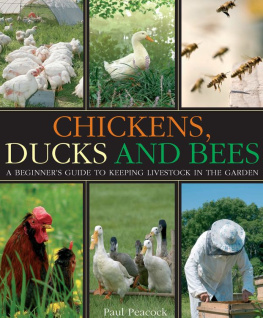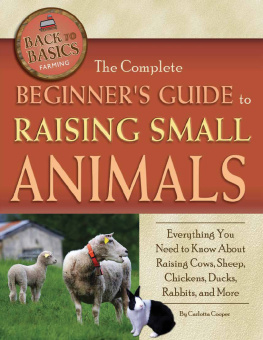STOREYS GUIDE TO RAISING DUCKS
SECOND EDITION
Storeys Guide to
RAISING DUCKS
Breeds Care
Care Health
Health

DAVE HOLDERREAD

The mission of Storey Publishing is to serve our customers by
publishing practical information that encourages
personal independence in harmony with the environment.
Edited by Sarah Guare and Deborah Burns
Art direction and book design by Cynthia N. McFarland
Cover design by Kent Lew
Text production by Jennifer Jepson Smith
Cover photograph by Jowita Stachowiak/iStockphoto
Authors photograph by Christopher David Miller Green
Interior photography by Dave Holderread
Illustrations by Elayne Sears
Indexed by Christine R. Lindemer, Boston Road Communications
2011, 2001 by W. David and Mildred M. Holderread
All rights reserved. No part of this book may be reproduced without written permission from the publisher, except by a reviewer who may quote brief passages or reproduce illustrations in a review with appropriate credits; nor may any part of this book be reproduced, stored in a retrieval system, or transmitted in any form or by any means electronic, mechanical, photocopying, recording, or other without written permission from the publisher.
The information in this book is true and complete to the best of our knowledge. All recommendations are made without guarantee on the part of the author or Storey Publishing. The author and publisher disclaim any liability in connection with the use of this information.
Storey books are available for special premium and promotional uses and for customized editions. For further information, please call 1-800-793-9396.
Storey Publishing
210 MASS MoCA Way
North Adams, MA 01247
www.storey.com
Printed in the United States by Versa Press
10 9 8 7 6 5 4 3 2 1
LIBRARY OF CONGRESS CATALOGING-IN-PUBLICATION DATA
Holderread, Dave.
Storeys guide to raising ducks / by Dave Holderread. 2nd ed.
p. cm.
Includes index.
ISBN 978-1-60342-692-3 (pbk. : alk. paper)
ISBN 978-1-60342-693-0 (hardcover : alk. paper)
1. Ducks. I. Title.
SF505.H65 2011
636.597dc22
2010030074
Contents
Acknowledgments
This book is possible because a host of people have shared their time, knowledge, and expertise over the years. Because a significant portion of the information contained herein was gained from research and observations made here at Holderread Waterfowl Farm & Preservation Center (HWF&PC), I am indebted to everyone who has helped keep this labor of love functioning. There is not room to mention everyone, but I want to acknowledge the following people for their key roles.
My parents, Rachel and Wilbur Holderread, who encouraged me throughout my childhood to pursue my fascination with all things feathered, and gave me a foundation in the art and science of animal husbandry.
Frank Braman, a talented poultry breeder and judge who took me under his wing in my early teens and taught me selection and breeding methods we use to maintain and improve the quality of the waterfowl raised here at HWF&PC.
D. Phillip Sponenberg, DVM, PhD, who has encouraged us in our work with endangered breeds and has been a valued resource for helping puzzle through genetics questions.
Carol Deppe, geneticist, plant breeder, and advocate for the integration of ducks and gardens, who challenged me to develop a uniform nomenclature for duck color genetics.
David Omick and Pearl Mast, who lend their design and building expertise, and are part of the advisory team of HWF&PC.
The Miller Green Family: Dale, who pinch-hits at chore time when needed and helps with technical support. Wanita, who has helped in all facets of HWF&PC for over 30 yearsfrom chores to webmaster to finding the photograph for the front cover of this book. Christopher and Maggie, who have been an integral part of our waterfowl program since they could walk. Christophers keen eye for simplifying tasks and Maggies devotion to helping injured animals heal are inspiring.
And most of all to Millie, my wife, who has been my biggest supporter and cohort as I have pursued my waterfowl passion. From daily farm chores to keeping volumes of records to editing my writingthis book would not have been possible without her numerous talents and willingness to pitch in wherever needed.
Foreword
The Importance of Ducks and This Book!
Ducks are the most underappreciated of all domesticated poultry and livestock species. It is hoped that this will change as more people learn about ducks, their characteristics, and their incredible productivity. This book provides wonderful coverage of both the basics and the details of duck production. Dave and Millie Holderread have spent many decades in working with ducks, and no other people are more qualified to pass along accurate and useful information about ducks.
Ducks, with their incredible array of different breeds, are important and useful resources for agriculture, yet also offer breeders much enjoyment. Each duck breed comes to us from a unique combination of place, people, and breeding goals, and each is well presented in this book.
Dave understands the intricacies of color genetics incredibly well and has shared that wealth here. He also sheds light on the fine points of breeding ducks for high levels of production both for eggs and for meat. The approaches in this book will ensure that ducks remain productive, hardy, beautiful, and enjoyable. Dave also clearly explains the finer points of selecting breeding birds for the production of great show birds.
The threat of losing distinct and productive breeds of ducks looms ever larger as the years go by. Conservation is ideally accomplished by lots of breeders raising lots of ducks, and selecting them for excellence in production, adaptability, soundness, and form. The approaches outlined here will enable the next generation of duck breeders to make great strides in the conservation of the genetic treasures that are contained in each breed package.
This book is a deep and useful resource for anyone from beginner to advanced breeder and is jam-packed with information available nowhere else. This includes recent scientific understandings and many insights and tricks from old-time breeders that are sure to contribute to success.
D. PHILLIP SPONENBERG, DVM, PHD
Professor of Pathology and Genetics, Virginia Tech
Technical Advisor, American Livestock Breeds Conservancy
1
Why Ducks?
THE POPULARITY OF DUCKS often described as the happiest animals in the barnyard is increasing in many areas of the world. It appears that the rest of us are beginning to understand what many Asians and Europeans have known for centuries ducks are one of the most versatile and useful of all domestic fowl. For many circumstances it is difficult to find a better all-purpose bird than the duck.
Next page



 Care
Care
